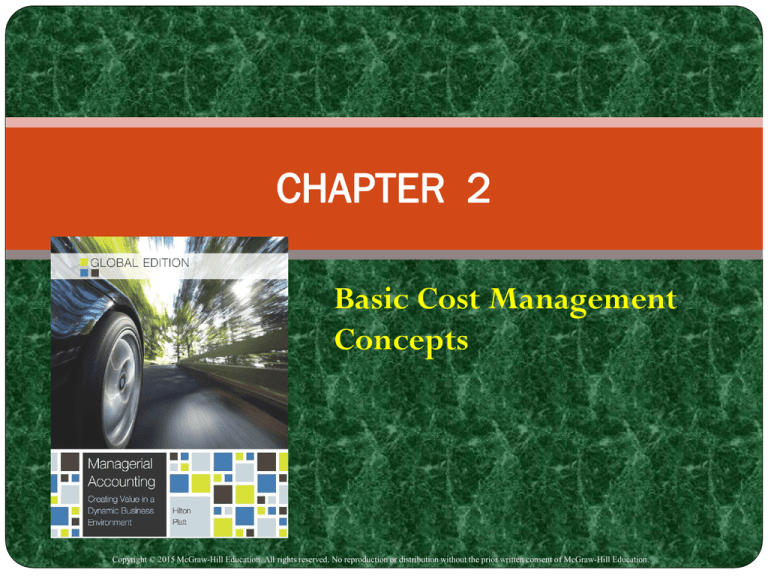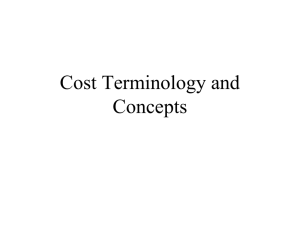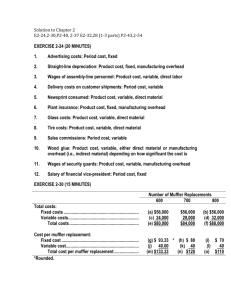
CHAPTER 2
Basic Cost Management
Concepts
Copyright © 2015 McGraw-Hill Education. All rights reserved. No reproduction or distribution without the prior written consent of McGraw-Hill Education.
What Do We Mean By a Cost?
A cost
is the measure of
resources given
up to achieve a
particular purpose.
2-2
Product Costs, Period Costs, and Expenses
Product costs are costs associated with goods for
sale until the time period during which the products
are sold, at which time the costs become expenses.
Period costs are costs that are expensed during the
time period in which they are incurred.
Expenses are the consumption of assets for the
purpose of generating revenue.
2-3
Cost Classifications on Financial
Statements – Income Statement
Product Costs
Period Costs
Cost of goods sold
Operating expenses
2-4
Cost Classifications on Financial
Statements – Balance Sheet
Manufacturer
Merchandiser
Current Assets
Current Assets
Cash
Receivables
Prepaid Expenses
Merchandise Inventory
Cash
Receivables
Prepaid Expenses
Inventories
Raw Materials
Work in Process
Finished Goods
2-5
Cost Classifications on Financial
Statements – Balance Sheet
Manufacturer
Merchandiser
Current Assets
Current Assets
Cash
Receivables
Prepaid Expenses
Merchandise Inventory
Cash materials
Those
waiting to be
Receivables
processed.
Prepaid
Expenses
Inventories
Raw Materials
Work in Process
Finished Goods
2-6
Cost Classifications on Financial
Statements – Balance Sheet
Merchandiser
Current Assets
Cash
Receivables
Prepaid Expenses
Merchandise Inventory
Manufacturer
PartiallyAssets
completed
Current
products – material to
Cash
which
some labor
Receivables
and/or
overhead has
been added.
Prepaid Expenses
Inventories
Raw Materials
Work in Process
Finished Goods
2-7
Cost Classifications on Financial
Statements – Balance Sheet
Manufacturer
Merchandiser
Current Assets
Cash
Receivables
Prepaid Expenses
Merchandise Inventory
Current Assets
Cash
Receivables
Completed
products
awaiting sale.
Prepaid Expenses
Inventories
Raw Materials
Work in Process
Finished Goods
2-8
Types of Production Processes
Type of Production
Process
Description of
Process
Example of
Manufacturer
Job Shop
Low volume
Little standardization
Unique products
Disney
Batch
Multiple products
Low volume
Caterpillar
Assembly Line
A few major products
Higher volume
Ford
Continuous Flow
High volume
Highly standardized commodity products
Exxon
2-9
Manufacturing Costs
Direct
Material
Direct
Labor
Manufacturing
Overhead
The
Product
2-10
Direct Material
Cost of raw material that is used to
make, and can be conveniently
traced, to the finished product.
Example:
Steel used to
manufacture
the automobile.
2-11
Direct Labor
Cost of salaries, wages, and fringe
benefits for personnel who work
directly on manufactured products.
Example:
Wages paid to an
automobile assembly
worker.
2-12
Manufacturing Overhead
All other manufacturing costs
Indirect
Material
Indirect
Labor
Other
Costs
Materials used to support
the production process.
Examples: lubricants and
cleaning supplies used in an
automobile assembly plant.
2-13
Manufacturing Overhead
All other manufacturing costs
Indirect
Material
Indirect
Labor
Other
Costs
Cost of personnel who
do not work directly on
the product. Examples:
maintenance workers,
janitors, and security
guards.
2-14
Manufacturing Overhead
All other manufacturing costs
Indirect
Material
Indirect
Labor
Other
Costs
Examples: depreciation
on plant and equipment,
property taxes,
insurance, utilities,
overtime premium, and
unavoidable idle time.
2-15
Classifications of Costs in Manufacturing
Companies
Manufacturing costs are often
combined as follows:
Direct
Material
Direct
Labor
Prime
Cost
Manufacturing
Overhead
Conversion
Cost
2-16
Manufacturing Cost Flows
Direct Material
Direct Labor
Work in
Process
Inventory
Manufacturing
Overhead
2-17
Manufacturing Cost Flows
Direct Material
Direct Labor
Work in
Process
Inventory
Manufacturing
Overhead
Finished
Goods
Inventory
2-18
Manufacturing Cost Flows
Direct Material
Direct Labor
Work in
Process
Inventory
Manufacturing
Overhead
Finished
Goods
Inventory
Cost of
Goods
Sold
2-19
Schedule of Cost of Goods
Manufactured
Comet Computer Corporation
Schedule of Cost of Goods Manufactured
Raw material used
$
134,980
50,000
230,000
Direct labor
Total manufacturing overhead
Total manufacturing costs
Add: Work-in-process inventory, January 1
$
414,980
120
Subtotal
Deduct: Work-in-process inventory, December 31
$
415,100
100
Cost of goods manufactured
$
415,000
2-20
Schedule Computation
of Costofof
Cost Goods
of Raw Material Used
Raw-material inventory, January 1
Manufactured
Add: Purchases of raw materials
6,000
134,000
Raw material available for use
Deduct: Raw material inventory, December 31
140,000
5,020
Raw material used
Comet Computer Corporation
$
$ 134,980
Schedule of Cost of Goods Manufactured
Raw material used
$
134,980
50,000
230,000
Direct labor
Total manufacturing overhead
Total manufacturing costs
Add: Work-in-process inventory, January 1
$
414,980
120
Subtotal
Deduct: Work-in-process inventory, December 31
$
415,100
100
Cost of goods manufactured
$
415,000
2-21
Schedule of Cost of Goods
Manufactured
Include all direct labor
costs incurred during the
period.
Corporation
Computer
Cometcurrent
Schedule of Cost of Goods Manufactured
Raw material used
$
134,980
50,000
230,000
Direct labor
Total manufacturing overhead
Total manufacturing costs
Add: Work-in-process inventory, January 1
$
414,980
120
Subtotal
Deduct: Work-in-process inventory, December 31
$
415,100
100
Cost of goods manufactured
$
415,000
2-22
Computation of Total Manufacturing Overhead
Indirect material
$
10,000
Indirect labor
40,000
Depreciation on factory
90,000
Depreciation on equipment
70,000
Utilities
15,000
Comet Computer Corporation
Insuranceof Cost of Goods Manufactured
5,000
Schedule
Total manufacturing overhead
$ 230,000
Raw material used
$
134,980
50,000
230,000
Direct labor
Total manufacturing overhead
Total manufacturing costs
Add: Work-in-process inventory, January 1
$
414,980
120
Subtotal
Deduct: Work-in-process inventory, December 31
$
415,100
100
Cost of goods manufactured
$
415,000
2-23
Schedule of Cost of Goods
Manufactured
Beginning work-inprocess inventory is
carried over from the
Comet Computer Corporation
prior period.
Schedule of Cost of Goods Manufactured
Raw material used
$
Direct labor
Total manufacturing overhead
Ending
work-in-process
Total manufacturing
costs
inventory
contains the
cost ofJanuary 1
Add: Work-in-process
inventory,
unfinished
goods, and is
Subtotal
reported
in the current inventory,
assets December 31
Deduct: Work-in-process
section
of themanufactured
balance sheet.
Cost of goods
134,980
50,000
230,000
$
414,980
120
$
415,100
100
$
415,000
2-24
Income Statement for a Manufacturer
Comet Computer Corporation
Income Statement
For the Year Ended December 31, 20X2
Sales revenue
Less: Cost of goods sold
$
700,000
415,010
Gross margin
Selling and administrative expenses
$
284,990
174,490
Income before taxes
Income tax expense
$
110,500
30,000
Net income
$
80,500
2-25
Comet Computer Corporation
Schedule of Cost of Goods Sold
For the Year Ended December 31, 20X2
Finished-goods inventory, Jan. 1
Add: Cost of goods manufactured
$
Cost of goods available for sale
Comet Computer Corporation
Deduct Finished-goods inventory, Dec. 31
200
415,000
415,200
190
Income Statement
$ 415,010
For the Year Ended December 31, 20X2
Cost of goods sold
Sales revenue
Less: Cost of goods sold
$
700,000
415,010
Gross margin
Selling and administrative expenses
$
284,990
174,490
Income before taxes
Income tax expense
$
110,500
30,000
Net income
$
80,500
2-26
Cost Classifications
Cost behavior means how a
cost will react to changes
in the level of business
activity.
Total variable costs change
when activity changes.
Total fixed costs remain
unchanged when activity
changes.
2-27
Total Variable Cost Example
Total Pay-Per-View
Bill
Your total cable pay-per-view bill is based on how many movies you
watch.
Pay-Per-View
Movies Watched
2-28
Variable Cost Per Unit Example
Per Movie Charge
The cost per movie watched is constant. For example, $4.00 per
movie.
Movies Watched
2-29
Total Fixed Cost Example
Monthly Charge for
HBO Bill
Your monthly cable bill probably does not change when you
watch movies on channels that you have elected to be paid on a
monthly basis (HBO).
Number of HBO Movies
Watched
2-30
Fixed Cost Per Unit Example
Monthly HBO Bill per Movie
Watched
The average cost per HBO movie decreases as more HBO movies are
watched.
Number of HBO
Movies Watched
2-31
Cost Classifications
Summary of Variable and Fixed Cost Behavior
Cost
In Total
Per Unit
Variable
Total variable cost changes
as activity level changes.
Variable cost per unit
remains the same over
wide ranges of activity.
Total fixed cost remains
the same even when the
activity level changes.
Fixed cost per unit
goes down as activity
level goes up.
Fixed
2-32
Direct and Indirect Costs
Direct costs
Indirect costs
Costs that can be
Costs that must be allocated
Example: cost of paint in the
Example: cost of national
easily and conveniently traced
to a product or department.
paint department of an
automobile assembly plant.
in order to be assigned to a
product or department.
advertising for an airline is
indirect to a particular flight.
2-33
Controllable and
Uncontrollable Costs
A cost that can be significantly influenced
by a manager is a controllable cost.
Cost item
Manager
Classificaton
Cost of food used Restaurant
in a restaurant
manager
Controllable
Cost of national
advertising by a
restaurant chain
Uncontrollable
Restaurant
manager
2-34
Opportunity Cost
The potential benefit that is given
up when one alternative is
selected over another.
Example: If you were
not attending college,
you could be earning
$30,000 per year.
Your opportunity cost
of attending college for one year is
$30,000.
2-35
Sunk Costs
All costs incurred in the past that cannot be changed by any
decision made now or in the future are sunk costs. Sunk
costs should not be considered in decisions.
Example: You bought an automobile that cost $22,000 two years ago.
The $22,000 cost is sunk because whether you drive it, park it, trade
it, or sell it, you cannot change the $22,000 cost.
2-36
Differential Costs
Costs that differ between alternatives.
Example: You can earn $1,500 per month in your
hometown or $2,000 per month in a nearby city.
Your commuting costs are $50 per month in your
hometown and $300 per month to the city.
What is your differential cost?
$300 - $50 = $250
2-37
Marginal Costs and Average Costs
The extra cost
incurred to produce
one additional unit.
The total cost to
produce a quantity
divided by the
quantity produced.
Marginal and average costs are
largely a function of cost behavior
-- variable and fixed costs.
2-38
Costs and Benefits of Information
Costs
Benefits
More information does not mean more
benefits if information overload results.
2-39
End of Chapter 2
2-40




